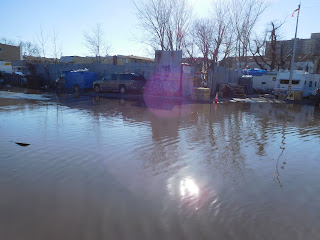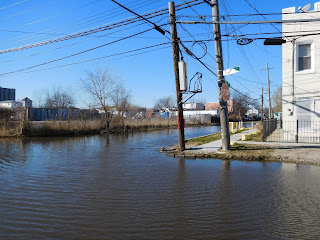Today I rode to a hole. No, I didn't go to the Grand Canyon.
Mind you, it wasn't my destination: I didn't have one for today. I just felt like riding and after an overcast morning turned into a sunny and unseasonably warm afternoon. I rode Vera, my green Mercian mixte, with no particular itinerary in mind. I just pedaled forward and turned whenever it looked interesting or I simply got tired of the street or lane I was riding.
I briefly covered a part of yesterday's ride: through Howard Beach and Beach Channel, the latter of which is partly contained in the Gateway National Recreation Area. Vera gave me a couple of brief encounters with the ocean, but the bodies of water I saw, mainly, were ones that open into the Atlantic--namely Jamaica Bay and Starrett Creek.
As we've all been told, immigrants of my grandparents' generation were lured to America by rumors that the streets were "paved with gold". Well, there is a street under that puddle, or whatever you want to call it, made of emerald. All right, that's a bit of an exaggeration. But the street is called Emerald Street. A block away is another venue called Ruby Street; nearby thoroughfares are Amber and Sapphire Streets.
In a perverse irony, these "jewel" streets comprise a neighborhood--if it might be called that--commonly called "The Hole." It's easy to see why: the land drops about five meters from the grade of Linden Boulevard--which itself lies below sea level. According to some reports, that puddle lies 30 feet (9 meters) below sea level.
In another twist, the nearest building that has any connection to the rest of the world is about 50 meters away but seems to have its back turned to it: a psychotherapy center. And, across Linden Boulevard--a.k.a. New York State Route 27--from it is the Lindenwood Diner, where travelers to and from JFK Airport and truckers to and from all points imaginable stop for burgers, shakes and such.
To give you an idea of how desolate--or, at least, how far removed from the rest of the city--The Hole is, no one seems to know whether it's in Brooklyn or Queens. Perhaps it's a separate borough? It certainly seems to exist in another time, if not jurisdiction.
That puddle in the photo might've been a result of the snow we had last week. But, from what I hear, there's almost always an unnatural wetland there. The Hole is, to my knowledge, the only part of New York City that doesn't have sewers--people use septic tanks and drains--because the land is too close to the water table.
That geographic feature is probably a reason why it most likely shares agrarian past with the neighboring Brooklyn community of East New York. In the late 19th Century, Brooklyn was--believe it or not--the second-largest (after southern New Jersey) vegetable-producing area in the US. No doubt some of the folks living there--off the grid--are growing tomatoes or cabbages or other vegetables in patches of sod surrounded by rubble-strewn or weed-grown lots. Most of the houses are abandoned; the people who call the area home are living in trailers, campers or trucks--with or without wheels.
The Federation of Black Cowboys stabled their horses in The Hole (and a few Cowboys lived there) until about a decade ago, when the city housing authority chased them out in order to erect middle-class housing that, to date, hasn't been built. In 2004, bodies of Mafia figures were found there, confirming longstanding rumors that the area was a mob dumping ground.
Anyway, I have a rule when I ride: If I can't see the bottom of any body of water I won't ride through it, unless there's no other way. Not even if I'm riding a bike with full fenders, as I was today!
The Federation of Black Cowboys stabled their horses in The Hole (and a few Cowboys lived there) until about a decade ago, when the city housing authority chased them out in order to erect middle-class housing that, to date, hasn't been built. In 2004, bodies of Mafia figures were found there, confirming longstanding rumors that the area was a mob dumping ground.
Anyway, I have a rule when I ride: If I can't see the bottom of any body of water I won't ride through it, unless there's no other way. Not even if I'm riding a bike with full fenders, as I was today!












Very interesting place. Thanks for this slice of NYC history.
ReplyDeleteHard to believe this little pocket of land could still exist so near the city this day and age. Shame on NYC for not addressing the drainage/sewer problem.
ReplyDeleteThanks for your very interesting posts about the hidden places you encounter on your rides; it's always an education.
Annie--Most historians of NYC admit they don't know much, if anything at all, about the Hole. It is interesting, indeed!
ReplyDeleteChris--Were it not such low-lying ground, or so close to (yet so far from!) the rest of NYC, one could think the place was in rural Arkansas or Appalachia. The streets aren't even paved!